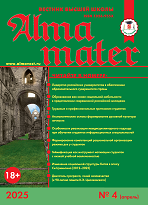UDC 316.6:(378+027.7)
https://doi.org/10.20339/AM.02-23.026
Sergei L. Talanov, PhD (Social science), Docent, Associate Professor of the Department of Political and Social Science at Yaroslavl State Pedagogical University, Head of the Yaroslavl Regional Office of the Russian Society of Sociologists, e-mail: talanov_sergei@mail.ru
The article analyzes reading skills, reading ability, erudition (knowledge of the studied works, understanding of literary concepts) and the ability to work with a book (definition and selection of books by genre, authors, topics), reading skills and abilities (perception, interpretation and evaluation of the work). For this purpose, diagnostic tasks and tests were used as part of the study. A sociological survey was conducted among students of leading universities in Central Federal District to determine their preferences, frequency and activity of reading. The relationship between reading frequency and academic performance was studied. It was found that preferences, frequency and activity of reading depend on family traditions, the level of education and education of the parents (or one of the parents), as well as on the influence of the reference personality (group). For students who have formed the skills and abilities of their own reading activity, developed reading and book skills, who consciously chose the direction of study and university, such students have high academic performance. Students who enrolled on the basis of whatever university and direction of study, for them books (reading) are a way of escaping reality (escapism, avoiding unpleasant, boring things in life). In addition, it has been established that for students from low-resource groups, books act as a prestigious element of social status, characterizing the level of education and education, which in reality does not exist not among parents, not among students. For this category of students, books are on the shelves as elements of social status, and not as tools with which you can improve your knowledge or take any behavioral models from the works for your daily practice. It has been established that girls mainly read foreign and domestic classics, and young men read historical, bibliographic books (Life of Remarkable People). Students from high-resource groups, when preparing for classes, primarily use the resources of their (parent) home library. Students from medium-resource and low-resource groups, when doing homework, writing essays, test papers, essays, use books from the university library. It was found that girls have a higher vocabulary, general knowledge and cultural awareness, as well as reading comprehension than boys. This is due to their love (sometimes habit) for systematic and purposeful reading. Students whose parents have higher education and high positions are able to search and find books necessary for development, and also have the habit of reading books. The higher the level of education of parents, the earlier they instill in their children a love of reading. Regular reading of short stories or novels outside of school leads to an increase in academic performance as part of university studies. Those who read paper books learn better than those who read digitized books on the Internet. Based on the results of the study, measures are proposed aimed at improving knowledge of the basics of grammar of the Russian language, expanding vocabulary, which is possible, first of all, through introducing students (youth) to the systematic reading of books.
Keywords and word combinations: books, reading competence, reading literacy, semantic reading, learning and reading activities.
References
- Talanov, S.L. Digital Etiquette in the Representations of Students (on the Materials of the Yaroslavl Region). Alma Mater (Vestnik vysshey shkoly). 2022. No. 4. P. 30–43. DOI: 10.20339/AM.04-22.030
- Kushnarev. F.Yu. Changes are inevitable: the main trends of digitalization of the educational process. In the book: Actual problems of improving higher education. Theses of reports of XIV All-Russian scientific and methodological conference. 2020. P. 184–186.
- Horowitz, R., Samuels, S.J. The achievement gap in reading: complex causes, persistent issues, possible solutions. Routledge, 2017. P. 170–184.
- Atteberry, A., McEachin, A. School’s out: The role of summers in understanding achievement disparities. Am Educ Res J. 2020. P. 1–44.
- Zebroff, D., Kaufman, D. Texting, reading, and other daily habits associated with adolescents’ literacy levels. Educ Inf Technol. 2017. 22 (5). P. 2197–2216.
- Sun, B., Loh, C.E., Curdt-Christiansen, X.L. Leisure reading in multilingual Singapore: reading enjoyment, habits and preferences of Singaporean children. J. Multilingual Theor Pract. 2020. 1 (2). P. 313–339.
- Loh, C.E., Sun, B. I’d still prefer to read the hard copy’: adolescents’ print and digital reading habits. J. Adolesc Adult Liter. 2019. 62 (6). P. 663–672.
- Selwyn, N., Nemorin, S., Bulfin, S., Johnson, N.F. The ‘obvious’ stuff: Exploring the mundane realities of students’ digital technology use in school. Dig Educ Rev. 2020. 37. P. 1–14.
- Jang, B.G., Ryoo, J.H. Multiple dimensions of adolescents’ reading attitudes and their relationship with reading comprehension. Read Writing. 2019. 32. P. 1769–1793.
- Clark, C., Picton, I. It makes me feel like I’m in a different place, not stuck inside: children and young people’s reading in 2020 before and during COVID-19 lockdown. National Literacy Trust. 2020.
- Zubova, O.G. Transformation of youth reading practices in modern Russian society. Society: Sociology, Psychology, Pedagogy. 2018. No. 10 (54). P. 32–35.
- Ladozhina, T.N., Bandorin, A.A. Involvement of youth in reading in modern information space through the organization of Reading Group. Personality in space and time. 2020. No. 9. P. 90–96.












.png)






